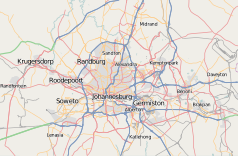Port lotniczy Johannesburg
 | |||||
| Państwo | |||||
|---|---|---|---|---|---|
| Miejscowość | Johannesburg | ||||
| Typ | cywilne | ||||
| Właściciel | Airports Company South Africa (ACSA) | ||||
| Data otwarcia | 1952 | ||||
| Kod IATA | JNB | ||||
| Kod ICAO | FAOR | ||||
| Wysokość | 1694 m n.p.m. | ||||
| Statystyki ruchu (2019[1]) | |||||
| Liczba pasażerów | 21 665 403 (+2%) | ||||
| Liczba operacji | 218 208 | ||||
| Drogi startowe | |||||
| |||||
Międzynarodowy Port lotniczy w Johannesburgu (IATA: JNB, ICAO: FAOR) - port lotniczy usytuowany w Kempton Park w Republice Południowej Afryki. Służy jako główny port lotniczy dla podróży krajowych i międzynarodowych RPA. Jest najbardziej ruchliwym lotniskiem w Afryce, z możliwością obsłużenia do 28 milionów pasażerów rocznie[2]. Lotnisko jest główną bazą operacyjną dla South African Airways. Lotnisko obsłużyło 21,65 miliona pasażerów w 2019 roku.
Na początku lotnisko było znane jako Jan Smuts International Airport[3] - nazywało się imieniem byłego premiera RPA. Lotnisko zmieniło nazwę na Międzynarodowy Port Lotniczy w Johannesburgu w 1994 r., kiedy nowo wybrany rząd Afrykańskiego Kongresu Narodowego (ANC), wprowadził politykę która nie pozwalała na nazywanie portów imionami polityków. Później zasada ta została zmieniona i 27 października 2006r. lotnisko zostało przemianowane na Międzynarodowy Port Lotniczy O. R. Tambo na cześć Olivera Reginalda Tambo, byłego prezydenta ANC[4].
Linie lotnicze i połączenia
Kierunki rozkładowe
Przypisy
- ↑ Airports Company South Africa - Passenger statistics. [dostęp 2010-06-01]. [zarchiwizowane z tego adresu (2012-08-28)].
- ↑ Chiara Fonio, Giovanni Pisapia, Security, surveillance and geographical patterns at the 2010 FIFA World Cup in Johannesburg, „The Geographical Journal”, 181 (3), 2014, s. 242–248, DOI: 10.1111/geoj.12089, ISSN 0016-7398 [dostęp 2020-05-20].
- ↑ Vic Mayhew, Illustrated guide to Southern Africa, wyd. 2nd ed, Cape Town: Published by Reader's Digest Association South Africa in association with T.V. Bulpin, 1980, ISBN 0-620-04650-3, OCLC 7665569 [dostęp 2020-05-20].
- ↑ Francis J. McGrath (red.), From John Mozley, Oxford University Press, 28 września 2006, s. 27–27, DOI: 10.1093/oseo/instance.00140825, ISBN 978-0-19-925459-0 [dostęp 2020-05-20].
Media użyte na tej stronie
Symbol lotniska do legendy mapy
Flag of Namibia
The flag of Navassa Island is simply the United States flag. It does not have a "local" flag or "unofficial" flag; it is an uninhabited island. The version with a profile view was based on Flags of the World and as a fictional design has no status warranting a place on any Wiki. It was made up by a random person with no connection to the island, it has never flown on the island, and it has never received any sort of recognition or validation by any authority. The person quoted on that page has no authority to bestow a flag, "unofficial" or otherwise, on the island.
Flag of Israel. Shows a Magen David (“Shield of David”) between two stripes. The Shield of David is a traditional Jewish symbol. The stripes symbolize a Jewish prayer shawl (tallit).
Flag of Ethiopia
Flag of Rwanda. The flag ratio is 2:3 with the stripes being 2:1:1. Colors are the following officially: Pantone 299 C 2X (blue), RAL 6029 (green), RAL 1023 (yellow) and RAL 1003 (golden yellow). (As of 03/08/2010, the only color used is the Pantone 299 C, which is from here. The rest of the colors are RAL shades from here.)
The national flag of the Democratic Republic of the Congo. Created according to the 2006 constitution : Son emblème est le drapeau bleu ciel, orné d’une étoile jaune dans le coin supérieur gauche et traversé en biais d’une bande rouge finement encadrée de jaune. (Its symbol is a sky blue flag, decorated with a yellow star in the upper left corner and crossed in the diagonal by a red strip with thin yellow borders) It seems to be identical, except for a lighter field hue, to the 1966–1971 flag.
Autor:
Johannesburg International Airport (aerial view).










































